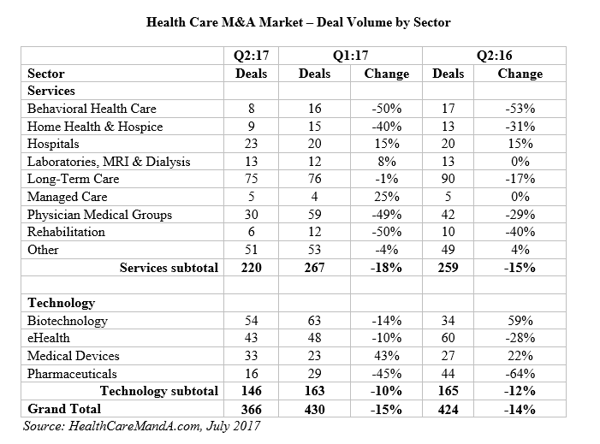Health care merger and acquisition activity slowed in the second quarter of 2017. Compared with the first quarter of 2017, deal volume decreased 15%, to 366 transactions. Deal volume was also lower compared with the same quarter the year before, down 14%.
Combined spending in the second quarter reached $95.8 billion, an increase of 62% compared with the $59.1 billion spent in the previous quarter, according to HealthCareMandA.com. Second quarter deal value was up 8% compared with the $88.7 billion spent in Q2:16.

Health care services transactions accounted for 52% of the second quarter’s dollar volume, much higher than the 14% share reported in the first quarter, and the 19% share recorded in Q2:16. The surge is due in part to investors’ acceptance that the Republicans’ replacement of the Affordable Care Act would be a longer process than many anticipated. These investors came back into the services side of the health care market, although the largest deals announced were for more ancillary services such as contract research organizations (CROs).
Only two of the services sectors posted gains in M&A activity in the second quarter, compared with the previous quarter. Hospital deals rose 15% and Managed Care transactions were up 25%, albeit on thin trading in both segments. Two sectors, Behavioral Health Care and Rehabilitation, saw declines of 50% in deal volume, while Physician Medical Groups (-49%) and Home Health & Hospice (-40%) were also hard hit. In the first quarter, Behavioral Health Care and Physician Medical Groups posted the highest gains in deal volume, so a slow-down in the second quarter is not totally unexpected. Deal volume in the post-acute sectors, especially, may remain lower due to concerns about the final form of the Republican healthcare bill.
On the technology side, only the Medical Device sector posted an increase (+43%) in transaction volume compared with the previous quarter. The Pharmaceutical sector posted its sixth straight decline in quarterly deal volume, down 45% to only 16 deals versus the first quarter. For the Big Pharma companies, big M&A deals are needed to fuel growth, but the C-suite is waiting to see how the Trump administration’s tax reform efforts fare before committing billions of dollars to a merger or acquisition. Deals for smaller companies won’t move the needle far enough, in this environment.
“Without definitive action in the second quarter to replace the Affordable Care Act, a lot of investors stayed on the sidelines,” said Lisa E. Phillips, editor of HealthCareMandA.com. “There is still an enormous pool of capital waiting to get into this market, and economic conditions remain favorable for the foreseeable future. It’s just a question of when, not if, these investors find the right assets to acquire.”
The fate of the ACA is still uncertain, even in mid-July, but some resolution may be nearing since the Senate has cancelled its usual August break in order to move legislation along. “Investors may use the continued uncertainty to discover opportunities in the healthcare market,” Ms. Phillips said. “Eight months after the national election, many have learned to invest in what looks good today, and not wait for tomorrow.”

